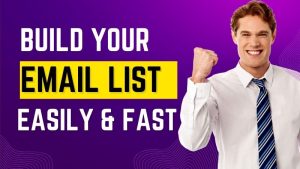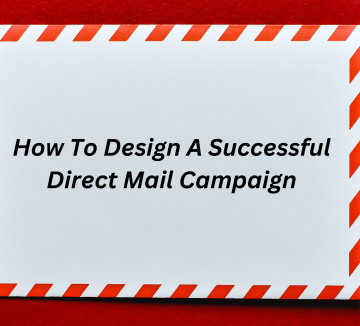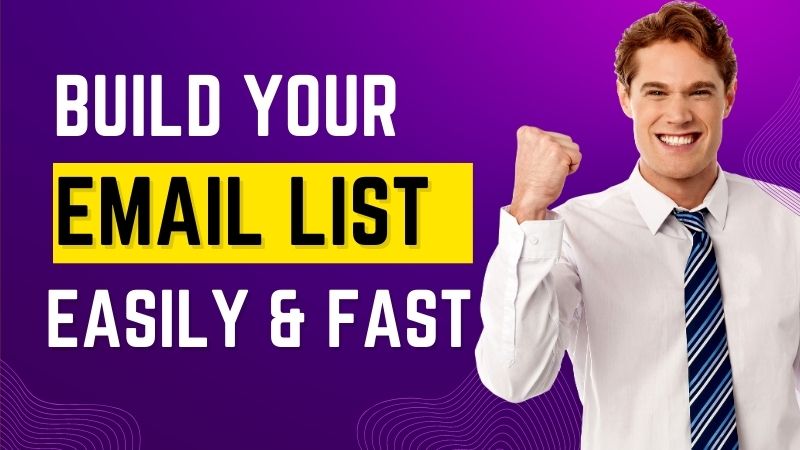Last Updated on April 7, 2023 by David
Building email list can be a challenging task, yet it is one of the most essential steps to effective email marketing for small businesses.
With an email list, businesses can communicate with customers and drive revenue through targeted and personalized email campaigns.
In this guide, we will walk you through the essential steps to building an email list, including advanced techniques for increased conversion rates, e-commerce, and lead generation.
We will cover comprehensive email list building guides, email marketing techniques, email marketing tools, email campaign creation, and email marketing automation.
You may also like:
- The Essential Email Marketing Metrics to Track
- 10 Proven Email Marketing Strategies To Increase Open Rates
- The Ultimate Guide to Email Marketing
Why Building Email List Matters
Building an email list allows small businesses to communicate with their customers and prospects directly.
Email marketing has the highest ROI among all digital marketing channels and can drive significant revenue for small businesses.
Additionally, an email list is an asset you own and can use to promote your products or services, drive traffic to your website, and generate sales.
Effective email list building can provide numerous benefits to small businesses. Some of the most notable benefits include:
- Increased revenue and customer retention
- Direct communication with customers
- Building brand awareness and loyalty
- Providing valuable insights and customer data
What is Email List Building?
Email list building is the process of creating a database of email subscribers who have opted in to receive promotional emails from your business.
These subscribers are potential customers who have shown an interest in your products or services and have given you permission to contact them through email.
Email list building is an important aspect of email marketing because it lets you directly communicate with your target audience, drive traffic to your website, and ultimately generate sales.
By building a quality email list, you can develop relationships with your subscribers, provide them with valuable information, and promote your products or services in an engaging and effective way.
Techniques for Building Email List
Now that you understand the importance of email list building let’s discuss some effective techniques for building an email list that can help you drive revenue and engagement for your small business.
In the following sections, we will cover the essential steps for creating an effective email list, including understanding your target audience, creating a lead magnet, setting up an opt-in form, generating traffic to your opt-in form, and implementing email marketing software.
We will also discuss how to craft your welcome email, develop an email marketing strategy, write compelling email copy, test and measure your email campaigns, and grow your email list through referral marketing and social proof.
By following these steps, you can create a comprehensive email list building strategy that helps you achieve your marketing goals and grow your small business.
Understanding Your Target Audience
Before you can begin building your email list, it is important to understand your target audience.
Your target audience is the people most likely to be interested in your products or services.
By understanding their needs, interests, and behavior, you can create a more effective email list building strategy that resonates with them and encourages them to subscribe to your email list.
The essential steps are identifying and understanding your target audience, including conducting market research and analyzing demographic and behavioral data.
Let us look at each of them:
- Identifying Your Target Audience
Identifying your target audience is the first and most crucial step in effective email list building. Knowing your audience will help you create targeted email campaigns that resonate with them and drive engagement. Research your ideal customer’s demographics, interests, and pain points.
- Understanding Their Needs and Interests
Once you have identified your target audience, it’s essential to understand their needs and interests. Conducting surveys, focus groups, and social media listening can help you gain valuable insights into your audience’s pain points, preferences, and purchasing habits.
- Conducting Market Research
Market research is an essential part of email list building. It involves gathering information about your competition, industry trends, and customer preferences to create effective email campaigns.
Use tools like Google Trends and SEMRush to research keywords and analyze competitor strategies.
Creating a Lead Magnet
One of the most important steps in building an effective email list is creating a lead magnet.
A lead magnet is an incentive that you offer to your website visitors in exchange for their contact information, such as their email address.
Your lead magnet should be relevant, valuable, and useful to your target audience, and should address a specific pain point or problem that they are facing.
There are several types of lead magnets that you can offer to your website visitors to encourage them to subscribe to your email list. Here are a few examples:
- eBooks and whitepapers: These are informative documents that provide in-depth information on a specific topic related to your business or industry.
- Checklists and cheat sheets: These are quick-reference guides that provide a list of steps or tips for achieving a specific goal or solving a problem.
- Webinars and video tutorials: These are online presentations or training sessions that provide valuable information on a specific topic.
- Free trials and demos: These are opportunities for your website visitors to try out your product or service before making a purchase.
- Resource libraries and toolkits: These are collections of resources such as templates, guides, or tools that your website visitors can use to solve a specific problem or achieve a specific goal.
Creating an effective lead magnet requires understanding your audience’s pain points and preferences.
Choose a topic that aligns with your business and provide actionable solutions that solve a specific problem for your audience.
The design of your lead magnet is crucial in attracting your target audience. Use high-quality visuals, compelling copy, and a clear call-to-action to encourage prospects to opt-in to your email list.
Here are important tips for creating an effective lead magnet for your email marketing campaign
Tips for creating an effective lead magnet:
- Solve a specific problem: Your lead magnet should address a specific pain point or problem that your target audience is facing. Make sure that your lead magnet is relevant and valuable to your target audience.
- Keep it simple: Your lead magnet should be easy to consume and understand. Use clear and concise language, and avoid technical jargon or complex concepts.
- Provide value: Your lead magnet should provide value to your target audience. Consider offering a discount, free trial, or exclusive content that is not available elsewhere.
- Make it visually appealing: Use high-quality images and design elements to make your lead magnet visually appealing. This will make it more engaging and increase the likelihood that your target audience will download it.
- Make it easy to access: Ensure that your lead magnet is easy to access and download. Use a simple opt-in form or landing page to capture your target audience’s contact information and deliver the lead magnet.
- Promote it effectively: Promote your lead magnet through your website, social media, and email marketing campaigns. Use compelling headlines and descriptions to encourage your target audience to download it.
- Test and optimize: Test your lead magnet with a small group of people to ensure that it is effective and resonates with your target audience. Use feedback to optimize your lead magnet and improve its effectiveness over time.
Setting Up an Opt-In Form
An opt-in form is a form that website visitors fill out to subscribe to your email list.
It’s important to follow opt-in form best practices to ensure that your opt-in form is effective in capturing leads and growing your email list.
Here are some best practices to follow:
- Keep your opt-in form simple: Your opt-in form should be simple and easy to fill out. Only ask for the information that you really need, such as a name and email address. Avoid asking for too much information, which can discourage people from subscribing.
- Offer a lead magnet: As discussed earlier, offering a lead magnet such as an eBook or a free trial can encourage people to subscribe to your email list. Make sure that your lead magnet is relevant to your target audience and provides value.
- Use clear and compelling copy: Your opt-in form should have clear and compelling copy that explains the benefits of subscribing to your email list. Use persuasive language and highlight the value of your content.
- Make it prominent: Your opt-in form should be prominently displayed on your website, preferably above the fold (the area of your website that is visible without scrolling down). Use a contrasting color or design to make it stand out.
- Test and optimize: Test different versions of your opt-in form to see what works best for your target audience. Try different headlines, copy, and design elements to optimize your opt-in form’s effectiveness.
Ideally, the opt-in form best practices are important because they can make a significant difference in your email list growth and engagement rates.
By keeping your opt-in form simple, offering a valuable lead magnet, using clear and compelling copy, making it prominent, and testing and optimizing, you can increase the number of subscribers to your email list and improve the quality of those subscribers.
By implementing these best practices, you can create an opt-in form that is effective in capturing leads and driving revenue for your small business.
Generating Traffic to Your Opt-In Form
Once you have created an effective opt-in form, the next step is to drive traffic to it.
Without traffic, your opt-in form will not be effective in growing your email list.
In this section, we will discuss strategies for generating traffic to your opt-in form, including content marketing strategies, social media marketing strategies, and paid advertising strategies.
By implementing these strategies, you can increase the visibility of your opt-in form and attract more subscribers to your email list.
- Content Marketing Strategies
Content marketing is an effective strategy for driving traffic to your opt-in form. Creating high-quality, educational content that resonates with your audience can attract visitors to your website and encourage them to subscribe to your email list.
- Social Media Marketing Strategies
Social media marketing is another effective way to generate traffic to your opt-in form. Use social media platforms like Facebook, Instagram, and Twitter to promote your lead magnet and drive traffic to your website.
- Paid Advertising Strategies
Paid advertising can provide an instant boost in traffic to your opt-in form. Use platforms like Google Ads and Facebook Ads to target your ideal customer with relevant messaging and drive them to your website.
Implementing Email Marketing Software
Once you have started to grow your email list, it’s important to have the right tools in place to manage and automate your email marketing campaigns.
Email marketing software can help you streamline your email marketing efforts and save time, while also providing valuable insights into your email campaign performance.
In this section, we will discuss the importance of choosing the right email marketing software, setting up your email marketing account, and creating an email list.
By implementing these steps, you can effectively manage and grow your email list, while also improving the effectiveness of your email marketing campaigns.
Here are important steps for implementing your email marketing software.
- Choosing the Right Email Marketing Software
Choosing the right email marketing software is essential for effective email list building. Consider factors such as pricing, features, integrations, and ease of use when choosing an email marketing software.
- Setting up Your Email Marketing Account
Setting up your email marketing account involves creating a new account, importing your email list, and setting up your email campaign. Most email marketing software providers offer tutorials and customer support to help you get started.
- Creating an Email List
Creating an email list involves importing your subscribers’ contact information into your email marketing software. Ensure that you have their permission to send them promotional emails, and segment your list based on demographics, interests, and behavior.
Crafting Your Welcome Email
A welcome email is an essential part of the email marketing process.
It sets the tone for your future email campaigns and establishes a relationship with your subscribers. A welcome email also helps to increase engagement rates and reduce email churn.
Elements of a Welcome Email
The key elements of a welcome email include:
- Subject Line: The subject line should be attention-grabbing and relevant to your target audience. It should clearly communicate the purpose of the email and encourage recipients to open it.
- Greeting: The greeting should be friendly and personalized, addressing the recipient by name.
- Introduction: The introduction should thank the recipient for subscribing to your email list and provide a brief overview of what they can expect from your emails.
- Branding: The email should include your brand’s logo, colors, and other visual elements to create brand recognition and familiarity.
- Value Proposition: The welcome email should clearly communicate the value that you will provide to your subscribers through your emails. This can include exclusive content, promotions, or other incentives.
- Call to Action: The welcome email should include a clear and prominent call to action (CTA) that encourages recipients to take action, such as visiting your website or following you on social media.
- Contact Information: The email should include contact information such as your business’s address, phone number, and email address to provide recipients with a way to contact you if they have any questions or concerns.
- Unsubscribe Link: The email should include an unsubscribe link, which allows recipients to easily opt-out of receiving future emails if they choose to do so.
By including these key elements in your welcome email, you can create a positive first impression with your subscribers and establish a strong foundation for building a relationship with them through email marketing.
Tips for Crafting an Effective Welcome Email
Crafting an effective welcome email is crucial in making a positive first impression and establishing a strong relationship with your subscribers.
Here are some tips to help you create an effective welcome email:
- Personalize your email: Use your subscriber’s first name in the greeting and throughout the email to make it more personal and engaging.
- Keep it concise: Keep your welcome email short and to the point, focusing on the most important information and benefits you can provide to your subscribers.
- Provide valuable content: Offer exclusive content, promotions, or incentives that provide value to your subscribers and encourage them to engage with your business.
- Use a clear and compelling subject line: The subject line is the first thing your subscribers see, so make it clear, concise, and compelling to encourage them to open your email.
- Set expectations: Let your subscribers know what they can expect from your email communications, such as the frequency and type of content they will receive.
- Use a clear call to action (CTA): Use a clear and prominent CTA to encourage your subscribers to take action, such as visiting your website, making a purchase, or following you on social media.
- Be authentic: Use a tone that is authentic and reflects your brand’s personality and values, and avoid generic or overly formal language.
- Test your email: Test your email with a small group of subscribers to make sure that it is effective and resonates with your target audience. Use feedback to optimize your welcome email and improve its effectiveness over time.
- Segment your audience: Segment your audience based on their interests and preferences, and personalize your welcome email content accordingly.
- Follow up: Follow up with your subscribers after they have received your welcome email to reinforce your relationship and encourage engagement with your brand.
By following these tips, you can craft an effective welcome email that engages your subscribers and encourages them to engage with your business through email marketing.
Developing an Email Marketing Strategy
Developing an email marketing strategy is crucial for the success of your email marketing campaigns.
In this section, we will discuss the steps involved in developing an effective email marketing strategy, including defining your email marketing goals, understanding different types of emails, creating an email marketing calendar, and segmentation and personalization.
- Defining Your Email Marketing Goals
Defining your email marketing goals is crucial for creating an effective email marketing strategy.
Consider goals such as increasing revenue, driving website traffic, promoting new products or services, and improving customer engagement.
- Understanding Different Types of Emails
Understanding the different types of emails can help you create effective email campaigns that resonate with your audience.
Types of emails include promotional emails, newsletters, transactional emails, and lead nurturing emails.
- Creating an Email Marketing Calendar
Creating an email marketing calendar involves planning your email campaigns in advance.
Use a tool like Google Calendar or Trello to plan your email campaigns and consider important dates such as holidays and seasonal events.
- Segmentation and Personalization
Segmentation and personalization are essential for effective email marketing.
Segment your email list based on demographics, interests, and behavior, and use personalization techniques such as dynamic content and personalized subject lines to increase engagement rates.
Writing Compelling Email Copy
Crafting compelling email copy is essential in capturing your subscribers’ attention and engaging them with your content.
In this section, we will discuss best practices for writing effective email copy, including tips and tricks for engaging your audience, optimizing your subject lines and preheaders, and crafting effective calls to action.
By implementing these strategies, you can improve the effectiveness of your email campaigns and drive more conversions and revenue for your small business.
Best practices for writing email copy:
Keeping the copy concise and scannable: Your subscribers are busy and may not have the time or patience to read a lengthy email.
Keep your copy concise, focusing on the most important information and breaking up your text into short paragraphs and bullet points for easy scanning.
Using a conversational tone: Writing in a conversational tone helps to establish a personal connection with your subscribers and makes your brand more relatable. Avoid using overly formal language and industry jargon, and instead use language that resonates with your target audience.
Highlighting the benefits of your products or services: Instead of focusing solely on the features of your products or services, highlight the benefits that they offer to your subscribers.
This helps to create a connection between your brand and your subscribers, and can increase the likelihood of conversions and sales.
Using clear calls-to-action: Every email should include a clear and prominent call-to-action (CTA) that encourages your subscribers to take action, such as making a purchase, downloading a resource, or visiting your website.
Use action-oriented language and make sure that your CTA is easy to find and understand.
Adding visual elements such as images or videos: Adding visual elements such as images or videos to your emails can help to break up your text and make your content more engaging. Use high-quality visuals that are relevant to your message and help to reinforce your brand’s visual identity.
By following these best practices, you can write effective email copy that engages your subscribers and drives conversions for your business.
Remember to test and analyze your results, and make adjustments as needed to optimize your email campaigns over time.
Testing and Measuring Your Email Campaigns
Testing and measuring your email campaigns is a crucial strategy for building an email list.
It helps you to optimize your email campaigns, improve engagement, and increase conversions.
In this section, we will discuss the importance of testing, A/B testing your email campaigns, and measuring your email campaign performance.
- A/B Testing Your Email Campaigns
A/B testing involves creating two versions of an email campaign and testing them against each other to determine the most effective elements.
Use A/B testing to optimize your subject lines, calls-to-action, and visual elements and improve engagement rates and conversion rates.
- Measuring Your Email Campaigns
Measuring the success of your email campaigns involves analyzing metrics such as open rates, click-through rates, conversion rates, and revenue generated.
Use this data to optimize your email campaigns and improve their effectiveness over time.
Bonus Tips For Growing Email List
Growing your email list is essential for the success of your email marketing campaigns.
In this section, we will discuss three bonus tips growing your email list:
- Implementing Referral Marketing
Referral marketing is a powerful strategy for growing your email list.
Encourage your existing subscribers to refer their friends and family to your email list, offering an incentive for each new subscriber they bring in.
This could be a discount code, a free resource, or other exclusive content. Referral marketing can help you to reach new audiences and build your email list quickly.
- Leveraging Social Proof
Social proof is the concept that people are more likely to trust and follow the actions of others.
Use social proof to your advantage by highlighting positive reviews, testimonials, and social media mentions from satisfied customers.
This can help to build trust with your target audience and encourage them to sign up for your email list.
- Host Giveaways and Contests
Giveaways and contests are a fun and engaging way to incentivize people to sign up for your email list.
Offer a prize or exclusive content to anyone who signs up for your email list or refers their friends to sign up.
This can help to generate excitement and buzz around your brand, and encourage people to share your content with their social networks.
By implementing these strategies, you can grow your email list and increase engagement with your target audience.
Remember to track and analyze your results, and make adjustments as needed to optimize your email marketing campaigns over time.
Conclusion
Effective email list building is essential for small businesses to succeed in the digital age.
By following the steps outlined in this guide, you can create an effective email list building strategy that drives revenue, increases customer engagement, and provides valuable insights into your audience.
Don’t forget to utilize email marketing techniques, email marketing tools, email campaign creation, email list building, and email marketing automation to take your email marketing efforts to the next level.




